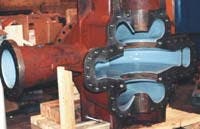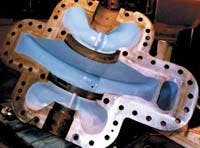Polymer Coating of Pumps Boosts Efficiency, Performance
By William Xia
In a typical surface water treatment and distribution system, approximately 70 to 90 percent of the energy used is for pumping. With the rising cost of electricity, more municipalities are searching for technologies to improve operational efficiency. One method for improving the efficiency of pumps is to line the pumps with a polymeric coating system.
Polymeric systems have been shown to provide increased flow at the desired pressure, increased pressure at the designed flow, increased efficiency over a wide range of flow rates and reduced power consumption. In many cases, new water pumps can also benefit from an efficiency coating for performance and protective purposes, even though pumps are normally not expected to outperform the original efficiency status certified by pump OEMs.
During the lifetime of a centrifugal pump, the cost of the energy it consumes is far in excess of the capital cost of the equipment itself. Therefore, efficient operation of the pump is essential to optimize operational costs since any increase in fluid efficiency gives immediate savings in power consumption. According to case studies, the typical payback period for a polymeric coating, based on reduced power consumption, can range from a few months to two years depending on the size of pump.
How Polymeric Coatings WorkMost of the energy used in moving water is actually expended in battling frictional drag in the water lines. Water flow in a pump is subject to resistance caused by volute and impeller surface friction and viscosity.In fluid dynamics, water molecules on the pump surfaces are stationary. Discrete water molecules in the flow behave as separate entities creating vortices and cross-currents which result in energy losses in addition to those arising from skin friction, which still continues to be exerted next to the boundary layer, in a thin film known as the laminar sub-layer. On relatively smooth surfaces, the thickness of this layer can be sufficient to cover surface projections, and the surface is said to be hydraulically smooth.
Where the surface is rough, however, the sub-layer can be so broken up by projections that they act as bluff obstacles, giving rise to form drag. Surface roughness, therefore, either by the effect it has on skin friction or form drag, is the most important factor in accounting for energy losses in a pump.
Even polished metal pump surfaces are found to be relatively rough when examined under high magnification. Further surface roughening can result from erosion-corrosion or cavitation effects, thus causing a reduction in efficiency of the system.
Polymer efficiency enhancement coatings are specifically designed as hydrophobic, slick surface coatings with low surface energy and abrasion resistant fillers. They produce an ultra smooth surface that reduces the boundary layer of the pumped fluid and reduces internal turbulence, thus increasing hydraulic efficiency.
The smoothness on the surface of this type of coating is 20 times greater than polished stainless steel. The coating's hydrophobic nature makes the water simply roll off the surface and wear by abrasion is minimized by its encapsulated blend of lubricating agents and abrasion resistant fillers.
When applied to fluid flow equipment, this type of coating has been proven to improve hydrodynamic performance by increasing overall efficiency through reducing power consumption, increasing fluid flow rates or pressure.
Some polymeric coatings have been deemed safe for potable water contact. This type of coating possesses worldwide approvals for drinking water contact, including those from NSF, AWWA, and authorities in European countries.
Today's polymers can produce compositions which can tackle virtually any pump problem. Besides the repair and protection from the damaging effects caused by abrasion, cavitation, corrosion and chemical attack, hydraulic efficiency improvement by reducing frictional energy losses has become a more and more acknowledged purpose of using polymers in pumps.
Selection, Application and OperationDue to large number of protective polymers and epoxy-based coatings in the market, selecting the right polymer coating for pump efficiency improvement can be confusing. However, there are only a few polymer coatings particularly engineered for pump efficiency improvement and effective in new pumps. Using coating products specifically for efficiency improvement and energy savings can attain the ultimate performance potential, while common protective polymer and epoxy coatings can always help old pumps improve performance.Polymeric coatings can be brush or spray applied in-situ to give a perfectly smooth high gloss finish. Coatings can be cured at ambient temperatures, and post cured to allow minimal downtime and fast return to service. Being able to carry out polymer coating in-house has led to faster contract turnaround, more competitive pricing, and better quality control.
In a typical application, two coats of different colors are applied by brush, applicator or spray at a typical thickness of 10 mil per coat. The self-leveling features of the coating product ensure a smooth surface finish. This finish and the coating thickness are critical factors behind the performance without changing the water flow characteristics of the equipment.
To ensure adhesion, surface preparation on the substrate is always required by grit blasting, rotary filing, etc. In cases where the pump's location is susceptible to dust contamination, sponge blasting offers a good option with a minimal amount of dust generation.
In pumps that have previously been in service, any severely worn or pitted areas can be brought back to the original contours by using a paste grade repair polymer compound before coating.
In order to document the effectiveness of the polymer efficiency coating in the real world, municipalities and water plants can use the coating on certain water pumps - either old or new - to help assess the technology for a broader practice.
Operators should document ratings with an electricity current gauge or hour-run meter, and use precise measuring instruments for flow rate and water head changes, if feasible, before and after applying polymer coatings. The return on investment can be computed from the comparison of the cost savings on energy, flow rate increase and the cost of the coating installation.
Case StudiesPolymer coating technology is not strange to the water industry. Many local municipalities, water consumers and equipment manufacturers have independently tested the effectiveness of efficiency coatings. Following are some examples:Fayetteville, NC, 1996After 20 years of service, a high-pressure pump at the Hoffer Water Plant revealed 14 percent efficiency loss compared to the original test and factory curve. An unusual noise had developed as well. The reconditioning of the pump included replacing wear rings, repairing minor impeller damage, and lining the entire interior surface of the pump with an efficiency improvement coating.The result after reconditioning was significant: pump efficiency is up 17 percent. After reviewing all the data, the local authority believed that the use of the polymer coating was responsible for at least 5 percent to 8 percent of the increase. In this application, a 1 percent increase in actual pump efficiency translated to nearly $1,000 per year in electrical savings. The cost of coating the pump was less than $2,500.
TVA Colbert Steam Plant, AlabamaBefore 1995, four 60 inch vertical circulating water pumps were coated with a polymeric coating to protect against erosion/corrosion and improve their efficiency. As soon as all wetted surfaces of the pumps diffusers, deflectors, impellers, casings, etc. were coated remarkable improvements in efficiency were observed.For example, in pump 5a, there was a 12 percent decrease in electrical usage from 100 amps (before) to 88 amps (after). The motor has been operating at 4160 volts. Assuming the resale of saved electricity at 4.4 cents / kWh, the total electrical savings were $28,411 within a year.
This increase in efficiency does not take into effect the increase in capacity provided by the polymeric coating. The other three pumps that were coated have had anywhere from a 10-15 percent increase in capacity. Five years later, the pumps were inspected and all coated components were in excellent shape without an obvious efficiency drop.
Trials on New Omega-Pump by KSB, 1999Trials were performed by applying an efficiency improvement coating to four new Omega pumps in sizes 250-480 hp. Afterward, an improvement in efficiency from 84 percent to 86.9 - 87.5 percent was measured. KSB acknowledged that the polymeric coating provided a 2.9 percent - 3.5 percent increase in efficiency in these four brand new pumps.Sulzer standardized on the use of polymer coatings after extensive performance testing. Coatings have been applied to numerous new pumps, resulting in performance gains. In one case, three identical pumps were coated with an efficiency coating before being shipped to customers. The three new split casing pumps were tested, and all had achieved a 3.5 percent increase in efficiency.
Testing on New ITT A-C Pump, 1996The casing of one new 24 X 16 WSID centrifugal pump was lined with two layers of a polymer coating, and the impeller blades were cleaned and polished. The OEM performance test exhibited a 3.1 percent gain at duty efficiency and 3.3 percent at the best efficiency point. The contributions from each individual procedure to the total success were uncertain. However, the gain from the efficiency coating was estimated to be at least 1.5 percent. Two other new units handled with exactly the same procedure passed the performance test with the same results.About the Author: William Xia is a chief engineer of water and wastewater industry for Belzona Inc., Miami, Florida. He is responsible for applying polymeric maintenance solutions to mechanical equipment and structures in the industry. Pump renovation and pump efficiency improvement are his major specialties.


